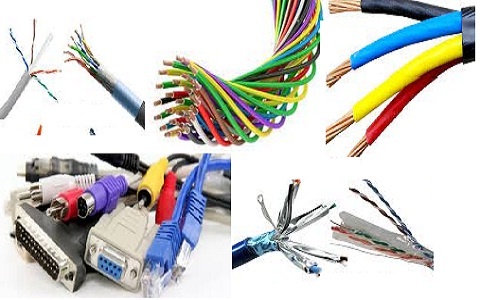Electrical Cables: Types and Applications Explained

Electrical Cables: Types and Applications Explained
Choosing the right electrical cable can make or break your project. Whether you’re rewiring your home, setting up a new office network, or working on an industrial installation, understanding the different types of electrical cables and their specific applications is essential for safety, efficiency, and code compliance.
Types of Electrical Cables
NM Cable (Non-Metallic Sheathed Cable)
NM cable is the most widely used residential wiring cable. This cable consists of two or more insulated conductors wrapped in a flexible plastic sheath, typically white, yellow, or black depending on the wire gauge.
The construction includes a bare copper ground wire alongside the insulated conductors. NM cable is designed for dry locations only and cannot be used in wet areas, underground, or in commercial buildings over three stories high.
Common applications include:
- Interior residential wiring
- Branch circuits for outlets and lighting
- Appliance connections in dry locations
- Basement and attic installations (when properly protected)
UF Cable (Underground Feeder Cable)
UF cable shares similarities with NM cable but features a solid plastic jacket that makes it suitable for direct burial and wet locations. The conductors are embedded in solid thermoplastic rather than individually wrapped, providing superior moisture protection.
This cable type can handle exposure to sunlight and varying soil conditions, making it ideal for outdoor electrical runs. UF cable must still comply with local burial depth requirements and may need additional protection in certain installations.
Primary uses include:
- Underground runs to outbuildings
- Outdoor lighting circuits
- Pool and spa electrical connections
- Buried electrical service to detached structures
THHN/THWN Cable
THHN (Thermoplastic High Heat-resistant Nylon-coated) and THWN (Thermoplastic Heat and Water-resistant Nylon-coated) cables are single conductors with thin insulation, designed primarily for use inside conduit systems.
These cables feature excellent heat resistance and can operate in temperatures up to 90°C (194°F) in dry locations. The THWN variant adds water resistance, making it suitable for wet locations when properly installed in appropriate conduit.
Common applications include:
- Commercial and industrial wiring
- Panel-to-panel connections
- Motor control circuits
- Any installation requiring conduit protection
Coaxial Cable
Coaxial cable features a central conductor surrounded by an insulating layer, a metallic shield, and an outer protective jacket. This design provides excellent signal integrity by minimizing electromagnetic interference.
The impedance rating (typically 50 or 75 ohms) determines the cable’s specific application. RG-6 and RG-59 are the most common types for residential and commercial use, with RG-6 offering better performance for high-frequency applications.
Standard uses include:
- Cable television distribution
- Internet connections (cable modems)
- CCTV and security camera systems
- Radio frequency applications
Fiber Optic Cable
Fiber optic cable transmits data using light pulses through glass or plastic fibers rather than electrical signals through copper conductors. This technology offers unmatched bandwidth capacity and immunity to electromagnetic interference.
Single-mode fibers carry signals over long distances with minimal loss, while multimode fibers are better suited for shorter runs with multiple light paths. The cable construction includes the optical fibers, strength members, and protective jacketing.
Key applications include:
- High-speed internet backbone connections
- Long-distance telecommunications
- Data center interconnections
- High-bandwidth network infrastructure
Armored Cable (BX Cable)
Armored cable, often called BX cable, features insulated conductors wrapped in a flexible metal sheath, typically made of galvanized steel or aluminum. This metal armor provides mechanical protection while maintaining flexibility for installation.
The armor serves as the equipment grounding conductor in most installations, eliminating the need for a separate ground wire. However, local codes may still require additional grounding methods in certain applications.
Common installations include:
- Industrial and commercial environments
- Areas requiring mechanical protection
- Exposed installations where NM cable isn’t permitted
- Retrofit wiring in older buildings
Low Smoke Zero Halogen (LSZH) Cable
LSZH cables use special jacket and insulation materials that produce minimal smoke and no halogen gases when exposed to fire. This characteristic makes them essential for enclosed spaces where smoke toxicity could pose serious health risks.
While typically more expensive than standard cables, LSZH cables provide critical safety benefits in specific environments. The reduced smoke production also helps maintain visibility during emergency evacuation procedures.
Primary applications include:
- Aircraft and marine installations
- Underground transit systems
- Enclosed plenum spaces
- Any environment where fire safety is paramount
Applications of Electrical Cables
Understanding cable applications goes beyond matching the right type to the job. Environmental factors, electrical load requirements, and local building codes all influence cable selection decisions.
Residential Applications
Home electrical systems rely heavily on NM cable for standard branch circuits, with UF cable handling outdoor and underground needs. Coaxial cable connects entertainment systems and internet services, while specialized cables may be needed for home automation systems or wiring harness assembly in custom installations.
Commercial and Industrial Uses
Commercial buildings often require THHN/THWN cables in conduit systems for flexibility and code compliance. Industrial environments may demand armored cables for mechanical protection, while data centers depend on fiber optic cables for high-speed communications.
Specialized Environments
Hospitals, schools, and transportation facilities frequently specify LSZH cables for enhanced fire safety. Marine and aviation applications have unique requirements that standard building cables cannot meet, necessitating specially rated products.
Code Compliance Considerations
Local electrical codes dictate many cable selection decisions. The National Electrical Code (NEC) provides baseline requirements, but local authorities may impose additional restrictions or requirements. Always verify code compliance before beginning any electrical installation.
Conclusion
Selecting electrical cables involves balancing performance requirements, environmental conditions, budget constraints, and code compliance. Start by identifying the specific application requirements, including voltage, current capacity, and environmental exposure.




